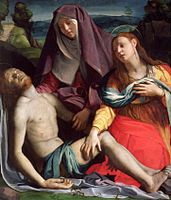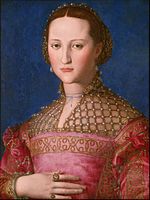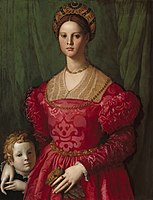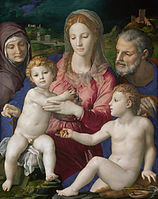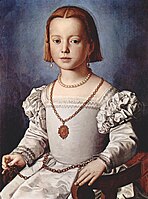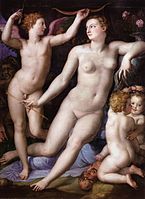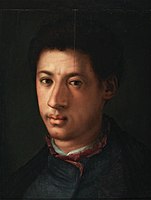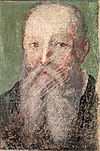Bronzino
Bronzino | |
|---|---|
 Portrait of Bronzino | |
| Born | Agnolo di Cosimo 17 November 1503 Florence, Republic of Florence |
| Died | November 23, 1572 (aged 69) Florence, Duchy of Florence |
| Nationality | Italian |
| Known for | Painting |
| Movement | Mannerism |
| Signature | |
 | |
Agnolo di Cosimo (Italian: [ˈaɲɲolo di ˈkɔːzimo]; 17 November 1503 – 23 November 1572), usually known as Bronzino (Italian: Il Bronzino [il bronˈdziːno]) or Agnolo Bronzino,[a] was an Italian Mannerist painter from Florence. His sobriquet, Bronzino, may refer to his relatively dark skin[1] or reddish hair.[2]
He lived all his life in Florence, and from his late 30s was kept busy as the court painter of
He trained with Pontormo, the leading Florentine painter of the first generation of Mannerism, and his style was greatly influenced by him, but his elegant and somewhat elongated figures always appear calm and somewhat reserved, lacking the agitation and emotion of those by his teacher. They have often been found cold and artificial, and his reputation suffered from the general critical disfavour attached to Mannerism in the 19th and early 20th centuries. Recent decades have been more appreciative of his art.
Life
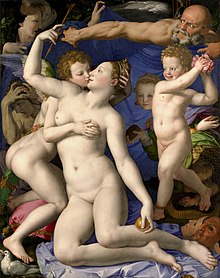
Bronzino was born in
Towards the end of his life, Bronzino took a prominent part in the activities of the Florentine Accademia delle Arti del Disegno, of which he was a founding member in 1563.
The painter Alessandro Allori was his favourite pupil, and Bronzino was living in the Allori family house at the time of his death in Florence in 1572 (Alessandro was also the father of Cristofano Allori).[5] Bronzino spent the majority of his career in Florence.

Work
Portraits

Bronzino first received Medici patronage in 1539, when he was one of the many artists chosen to execute the elaborate decorations for the wedding of
Bronzino's best-known works comprise the aforementioned series of the duke and duchess,
Bronzino's so-called "allegorical portraits", such as that of a Genoese admiral, Portrait of Andrea Doria as Neptune, are less typical but possibly even more fascinating owing to the peculiarity of placing a publicly recognized personality in the nude as a mythical figure.[7] Finally, in addition to being a painter, Bronzino was also a poet, and his most personal portraits are perhaps those of other literary figures such as that of his friend the poet Laura Battiferri.[8] The eroticized nature of these virile nude male portraits, as well as homoerotic references in his poetry, have led scholars to believe that Bronzino was homosexual.[2]
Religious and allegorical subjects

In 1540/41, Bronzino began work on the fresco decoration of the Chapel of Eleanora di Toledo in the
Bronzino's work tends to include sophisticated references to earlier painters, as in one of his last grand frescoes called The Martyrdom of St. Lawrence (San Lorenzo, 1569), in which almost every one of the extraordinarily contorted poses can be traced back to
Many of Bronzino's works are still in Florence but other examples can be found in the
Selected works

- St. Mark (c. 1525) – Oil on Wood, Capponi Chapel, Santa Felicita, Florence
- St. Matthew (c. 1525) – Oil on Wood, Capponi Chapel, Santa Felicita, Florence
- Portrait of Lorenzo Lenzi (1527–28) – Oil on panel, castello Sforzesco, Milan
- Pietà (c. 1530) – Oil on panel, 105 x 100 cm, Uffizi, Florence
- Portrait of Dante (1530) – Oil on panel, Milan
- Portrait of a Lady in Green (1530–32) – Oil on panel, 76,7 x 65,4 cm, Royal Collection, Windsor
- St. Sebastian (c. 1533) – Oil on panel, 87 x 77 cm, Museo Thyssen-Bornemisza, Madrid
- Holy Family (1534–40) – Oil on wood, 124.5 x 99.5 cm, Kunsthistorisches Museum, Vienna
- Adoration of the Shepherds (1535–1540) – Oil on wood, 65,3 x 46,7 cm, Museum of Fine Arts, Budapest
- State Museums, Berlin
- Portrait of Bartolomeo Panciatichi (c. 1540) – Tempera on wood, 104 x 84 cm, Uffizi, Florence
- Holy Family (c. 1540) – Oil on wood, 117 x 93 cm, Uffizi, Florence
- Portrait of a Young Man with a Book (c. 1540) – Oil on wood, 96 x 75 cm, Metropolitan Museum of Art, New York
- National Gallery, London
- Adoration of the Bronze Snake (1540–45) – Fresco, 320 x 385 cm, Palazzo Vecchio, Florence
- Deposition of Christ (1540–45) – Oil on panel, 268 x 173 cm, Musée des Beaux- Arts, Besançon
- Alessandro de Médici (1540–1553) – Oil on panel, 34,90 x 26,20 cm, Cerralbo Museum, Madrid.
- Crossing of the Red Sea (1541–42) – Fresco, 320 x 490 cm, Palazzo Vecchio, Florence
- Portrait of a Young Girl (1541–45) – Oil on wood, 58 x 46,5 cm, Uffizi, Florence
- Portrait of Bia de' Medici (c. 1542) – Tempera on panel, 63 x 48 cm, Uffizi, Florence
- Portrait of Cosimo I de' Medici (1545) – Oil on panel, 74 x 58 cm, Uffizi, Florence
- Portrait of Cosimo I de' Medici (c. 1545) – Oil on panel, 76,5 x 59 cm, Museo Thyssen-Bornemisza, Madrid.
- Portrait of Giovanni de' Medici as a Child (c. 1545) – Oil on wood, 58 x 46 cm, Uffizi, Florence
- Portrait of Eleanor of Toledo (c. 1545) – Oil on panel, 115 x 96 cm, Uffizi, Florence
- Portrait of Lucrezia Panciatichi (c. 1545) – Oil on panel, 101 x 82.8 cm, Uffizi, Florence
- Christ on the Cross (c. 1545) – Oil on panel, 145 x 115 cm, Musée des Beaux-Arts, Nice
- Portrait of Stefano Colonna (1546) – Oil on panel, 125 x 95 cm, Galleria Nazionale d'Arte Antica, Rome
- Portrait of Don Garcia de' Medici (1550) – Oil on panel, Museo del Prado, Madrid
- Portrait of a Lady (c. 1550) – Oil on wood, 109 x 85 cm, Galleria Sabauda, Turin
- PortraIt of a Young Man (possibly Pierino da Vinci) (c. 1550)[10]
- Venus, Cupid and Jealousy (or Envy) (c. 1550) – Oil on wood, 192 x 142 cm, Szépművészeti Múzeum, Budapest
- Portrait of Andrea Doria as Neptune (1550–1555) – Oil on canvas, 115 x 53 cm, Pinacoteca di Brera, Milan
- St. John the Baptist (1550–1555) – Oil on wood, 120 x 92 cm, Galleria Borghese, Rome
- Portrait of Pierantonio Bandini (c. 1550–1555) – Oil on wood, 106,7 x 82,5 cm, National Gallery of Canada
- Portrait of Francesco I de' Medici (1551) – Tempera on wood, 58.5 x 41.5 cm, Uffizi, Florence
- Portrait of Maria de' Medici (1551) – Tempera on wood, 52.5 x 38 cm, Uffizi, Florence
- Portrait of Ludovico Capponi (1551) – Oil on wood, 117 x 86 cm, Frick Collection, New York
- Christ in Limbo, 1552, Florence, Museo dell'Opera di Santa Croce
- Portrait of the Dwarf Nano Morgante (1552)[11]
- Holy Family (1555–1560) – Tempera on wood, 117 x 99 cm, Pushkin Museum, Moscow
- Portrait of Laura Battiferri (1555–1560) – Oil on canvas, 83 x 60 cm, Palazzo Vecchio, Florence
- Noli me tangere (1561) – Oil on canvas, 291 x 195 cm, Musée du Louvre, Paris
- Allegory of Happiness (1564) – Oil on copper, 40 x 30 cm, Uffizi, Florence
- Deposition of Christ (1565) – Oil on wood, 350 x 235 cm, Galleria dell'Accademia, Florence
- Martyrdom of St. Lawrence (1569) – Fresco, San Lorenzo, Florence
- Works
-
Pietà, 1530
-
Saint Sebastian, 1533, Museo Thyssen-Bornemisza, Madrid
-
Andrea Doria as Neptune, 1550–55, Pinacoteca di Brera, Milan
-
Portrait of Eleonora of Toledo, c. 1539
-
A portrait of an unknown woman and boy, c. 1540
-
Portrait of Bartolomeo Panciatichi, c. 1540
-
Portrait of Laura Battiferri, 1555–60
-
Holy Family with St. Anne and the Infant St. John, 1545
-
Portrait of Bia de' Medici, 1545
-
Portrait of a Man Holding a Statuette, 1545
-
Sacra famiglia Panciatichi or Madonna Panciatichi, 1545
-
Portrait of Stefano Colonna, 1546
-
Portrait Cosimo I de' Medici in armour, c. 1545
-
Ugolino Martelli, c. 1537
-
Portrait of Cosimo I de' Medici as Orpheus, c. 1537–39
-
Venus, Cupid and Envy, c. 1548–50
-
John the Baptist, 1553
-
Garcia de' Medici, Prado Museum
-
Alessandro de' Medici, Cerralbo Museum
References
Footnotes
- ^ Mistaken attempts also have been made in the past to assert his name was Agnolo Tori and even Angelo (Agnolo) Allori.
Citations
| External videos | |
|---|---|
 | |
- ISBN 978-0-19-102417-7.
- ^ ISBN 9781135578718.
- ^ Elizabeth Pilliod, Pontormo, Bronzino, and Allori: A Genealogy of Florentine Art (New Haven, CT: Yale University Press, 2001).
- ^ Web Gallery of Art, image collection, virtual museum, searchable database of European fine arts (1100–1850)
- ISBN 0-947645-22-5
- ^ Janet Cox-Rearick, Splendors of the Renaissance: reconstructions of historic costumes from King Studio, Italy by Fausto Fornasori, Catalog of an exhibition held at Art Gallery of the Graduate Center, City University of New York, Mar. 10–Apr. 24, 2004, (King Studio, 2004)
- ^ Maurice Brock, Bronzino (Paris: Flammarion; London: Thames & Hudson, 2002).
- ^ Deborah, Parker, Bronzino: Renaissance Painter as Poet (Cambridge and New York: Cambridge University Press, 2000).
- ^ Janet Cox-Rearick, Bronzino's Chapel of Eleonora in the Palazzo Vecchio (Berkeley: University of California Press, 1993).
- ^ "Bronzino (Agnolo di Cosimo di Mariano) | Portrait of a Young Man, Possibly Pierino da Vinci".
- ^ "Morgante: Depictions of a Renaissance Jester Turned Duke".
- ^ "Bronzino and The Mannerist Portrait". Smarthistory at Khan Academy. Archived from the original on October 7, 2014. Retrieved January 6, 2013.
- ^ "Bronzino's Portrait of Eleonora di Toledo with her son Giovanni". Smarthistory at Khan Academy. Archived from the original on October 22, 2014. Retrieved January 6, 2013.
Further reading
- Maurice Brock, Bronzino, Edition du Régard, Paris 2002. ISBN 2-84105-140-4
- The Drawings of Bronzino, exh. cat. ed. by Carmen C. Bambach, contr. by Elizabeth Pilliod, Marzia Faietti, Janet Cox-Rearick, Philippe Costamagna, The Metropolitan Museum of Art, New York ISBN 978-1-58839-354-8, 978-0-300-15512-9
- Bronzino: pittore e poeta alla corte dei Medici, exh. cat. ed. by Antonio Natali e Carlo Falciani, Palazzo Strozzi, Florence 2010–11. ISBN 978-88-7461-153-9.
External links
- Bronzino: artist and poet. InToscana.
- Agnolo Bronzino's Biography, Style and Artworks
- The National Gallery: Agnolo Bronzino
- Biography Angolo Bronzino at Encyclopaedia Britannica
- Palazzo Strozzi, Florence/Bruce Adolphe's "Of Art and Onions: Homage to Bronzino"
- Italian Paintings: Florentine School, a collection catalog containing information about the artist and his works (see pages: 200–204).

